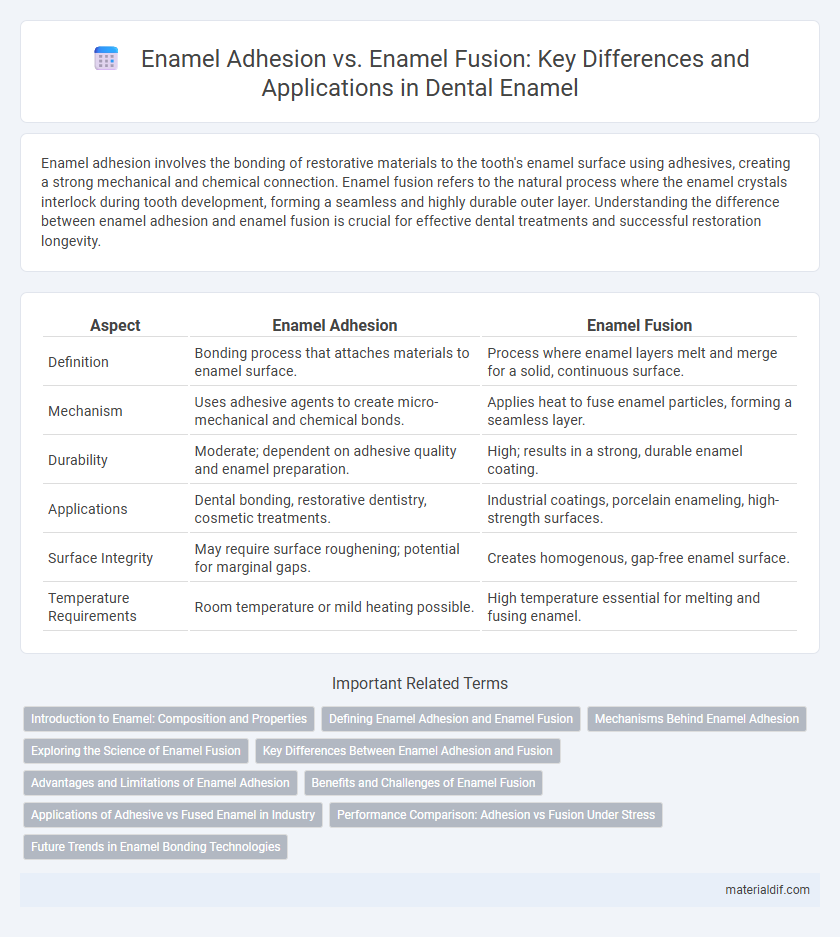Enamel adhesion involves the bonding of restorative materials to the tooth's enamel surface using adhesives, creating a strong mechanical and chemical connection. Enamel fusion refers to the natural process where the enamel crystals interlock during tooth development, forming a seamless and highly durable outer layer. Understanding the difference between enamel adhesion and enamel fusion is crucial for effective dental treatments and successful restoration longevity.
Table of Comparison
| Aspect | Enamel Adhesion | Enamel Fusion |
|---|---|---|
| Definition | Bonding process that attaches materials to enamel surface. | Process where enamel layers melt and merge for a solid, continuous surface. |
| Mechanism | Uses adhesive agents to create micro-mechanical and chemical bonds. | Applies heat to fuse enamel particles, forming a seamless layer. |
| Durability | Moderate; dependent on adhesive quality and enamel preparation. | High; results in a strong, durable enamel coating. |
| Applications | Dental bonding, restorative dentistry, cosmetic treatments. | Industrial coatings, porcelain enameling, high-strength surfaces. |
| Surface Integrity | May require surface roughening; potential for marginal gaps. | Creates homogenous, gap-free enamel surface. |
| Temperature Requirements | Room temperature or mild heating possible. | High temperature essential for melting and fusing enamel. |
Introduction to Enamel: Composition and Properties
Enamel adhesion involves the chemical and mechanical bonding of restorative materials to the enamel surface, ensuring durability and resistance to failure. In contrast, enamel fusion refers to the natural process where enamel crystals grow and interlock during tooth development, creating a highly mineralized, resilient outer layer composed primarily of hydroxyapatite. Understanding enamel's composition--approximately 96% mineral content by weight and its unique microstructure--is crucial for optimizing adhesion techniques in dental treatments.
Defining Enamel Adhesion and Enamel Fusion
Enamel adhesion refers to the process where dental materials chemically or physically bond to the enamel surface, creating a strong attachment essential for restorative procedures. Enamel fusion involves the natural enamel crystals merging during tooth development, resulting in a seamless, highly mineralized outer layer with superior structural integrity. Understanding the distinction between enamel adhesion and enamel fusion is crucial for optimizing dental treatments and improving restoration longevity.
Mechanisms Behind Enamel Adhesion
Enamel adhesion relies on micro-mechanical interlocking and chemical bonding between the enamel surface and adhesive materials, achieved through acid etching that creates microporosities. The key mechanism involves the infiltration of resin monomers into enamel prisms, forming a hybrid layer that enhances bond strength. Unlike enamel fusion, which is a natural developmental process forming the enamel layer, enamel adhesion is a restorative technique aimed at creating a durable interface for dental materials.
Exploring the Science of Enamel Fusion
Enamel fusion refers to the natural process where enamel crystals grow together seamlessly, creating a strong, durable bond essential for tooth integrity. In contrast, enamel adhesion involves the use of dental materials to attach restorative substances to tooth surfaces, relying on chemical and mechanical interactions. Understanding the microscopic crystallography and chemistry behind enamel fusion helps advance biomimetic techniques that improve adhesive dentistry outcomes.
Key Differences Between Enamel Adhesion and Fusion
Enamel adhesion refers to the chemical or mechanical bonding of restorative materials to the enamel surface, creating a durable interface essential for dental treatments such as veneers or fillings. Enamel fusion, on the other hand, involves the morphological union of enamel crystals during tooth development or in enamel repair technologies, resulting in a seamless and continuous enamel layer. Key differences between enamel adhesion and fusion lie in their biological origins, with adhesion relying on external bonding agents and fusion being a natural or synthetic integration process of enamel structure.
Advantages and Limitations of Enamel Adhesion
Enamel adhesion provides the advantage of preserving natural tooth structure by bonding restorative materials directly to the enamel surface, resulting in minimal invasive procedures and enhanced aesthetic outcomes. However, limitations include sensitivity to moisture contamination during application, which can compromise bond strength, and potential degradation over time due to oral environment factors. Enamel adhesion also requires meticulous surface preparation and technique sensitivity, which may pose challenges for consistent clinical success.
Benefits and Challenges of Enamel Fusion
Enamel fusion offers superior structural integrity by creating a seamless bond between the enamel layer and underlying tissues, enhancing durability and resistance to corrosion compared to enamel adhesion. This process minimizes the risk of delamination and improves aesthetic uniformity, making it ideal for dental restorations and protective coatings. Challenges include the necessity for precise temperature control and potential thermal stress, which can cause microcracks or distortion during the fusion process.
Applications of Adhesive vs Fused Enamel in Industry
Adhesive enamel is widely used for coating metal surfaces in the electronics and automotive industries due to its strong bonding properties and ability to withstand mechanical stresses. Fused enamel, applied through high-temperature firing, is preferred in cookware and architectural panels for its durable, glass-like finish offering excellent corrosion and heat resistance. Industrial applications select adhesive enamel for flexibility and ease of application, while fused enamel is favored for long-term durability and chemical inertness.
Performance Comparison: Adhesion vs Fusion Under Stress
Enamel adhesion relies on bonding agents to create a mechanical and chemical link between the enamel surface and restorative materials, achieving strong performance under moderate stress but susceptible to debonding over time. Enamel fusion, involving the melting and re-solidification of enamel layers, forms a seamless, integrated structure with superior resistance to shear and tensile forces during high-stress conditions. Performance comparison shows enamel fusion maintains structural integrity better under cyclic loading and thermal fluctuations, whereas adhesion methods may fail due to interface degradation or microleakage.
Future Trends in Enamel Bonding Technologies
Future trends in enamel bonding technologies emphasize enhanced adhesive formulations that improve bond strength and durability while minimizing enamel damage. Nanotechnology integration and bioactive materials are driving innovations that promote remineralization and self-healing properties at the enamel-adhesive interface. Advanced laser and surface treatment methods are being developed to optimize enamel surface energy, ensuring superior bonding efficiency and longevity in restorative dentistry.
enamel adhesion vs enamel fusion Infographic

 materialdif.com
materialdif.com